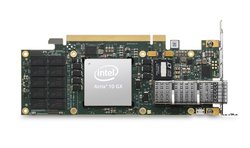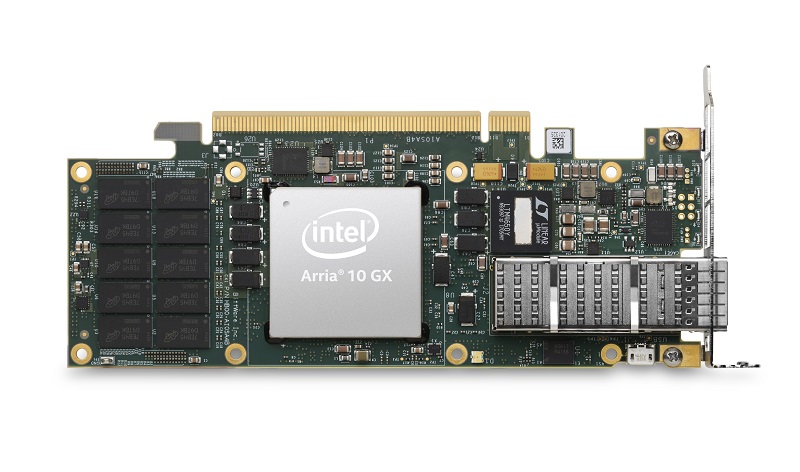
April 13, 2018
By: Michael Feldman
Intel announced Fujitsu and Dell EMC will offer servers with Intel’s Arria 10 GX field programmable gate array (FPGA) accelerators, along with a supporting software stack.
 The Arria 10 GX devices are designed to speed up a range of datacenter workloads, including financial trading, genomics, seismic processing, artificial intelligence, video transcoding, and cybersecurity. The press release announcing the OEM adoptions offered the example of a financial modeling application accelerated by Intel partner Levyx, a provider of high performance data analytics software.
The Arria 10 GX devices are designed to speed up a range of datacenter workloads, including financial trading, genomics, seismic processing, artificial intelligence, video transcoding, and cybersecurity. The press release announcing the OEM adoptions offered the example of a financial modeling application accelerated by Intel partner Levyx, a provider of high performance data analytics software.
“Financial modeling is a big data problem with huge performance sensitivities,” said Matt Meinel, senior vice president of business development for Levyx. “Utilizing the Intel PAC and the Acceleration Stack, our architects and software developers achieved an eight-fold improvement in algorithm execution and twice the speed in options calculation compared to traditional Spark implementations.”
Dell EMC is offering the Arria 10 GX on its PowerEdge R640, R740 and R740XD, while Fujitsu is providing the option on its x86-based PRIMERGY servers. In both cases, the FPGA will be deployed as part of a PCIe-attached Programmable Acceleration Card (PAC), and will be paired with one or more Xeon CPUs, which will act as host processors.
The PAC devices come with 8 GB of their own DDR memory and 128 MB of flash. For single precision math, the Arria 10 GX delivers up to 1,519 GFLOPS or 3,714 GMACS (fixed point multiply-accumulate operations), all for about 60 watts of power. Getting that amount of computation in such a small power envelop has been one of the major draws of FPGAs. However, the difficulty of programming them has relegated FGPAs to niche applications in the datacenter, which exactly what Intel wants to change.
The programming challenge is being addressed directly by Intel with its Acceleration Stack, a collection of APIs, drivers, various libraries, and developer tools, aimed at speeding up application development and expanding the FPGA software base. It includes an SDK for OpenCL and Quartus Prime for developing FPGA applications on Intel hardware, plus an open source acceleration engine, known as the Open Programmable Acceleration Engine (OPAE). Taken together, the stack aims to abstract away some of the low-level intricacies of programming theses devices and make them look more like programmable ASICs.
The other piece of this is getting the OEMS on board. When Intel bought Altera in 2015, company execs predicted FPGAs will be used in 30 percent of datacenter servers by 2020. To date, the biggest datacenter deployment of field programmable gate arrays is by Microsoft, which is using Intel FPGAs to accelerate a number of workloads in its Azure cloud. In this case though, Microsoft designed its own servers, as part of its Project Catapult effort, and used ODMs to build the requisite hardware.
But if you’re not running a hyperscale though, you’re probably going to rely on OEMs for your server needs. Fujitsu and Dell EMC are a good start in that regard, inasmuch as they cover a lot of territory, both geographically and from market perspective. And if these two vendors find success selling these FPGA-enhanced servers, there will surely be others to follow.
Image source; Intel Corp.
